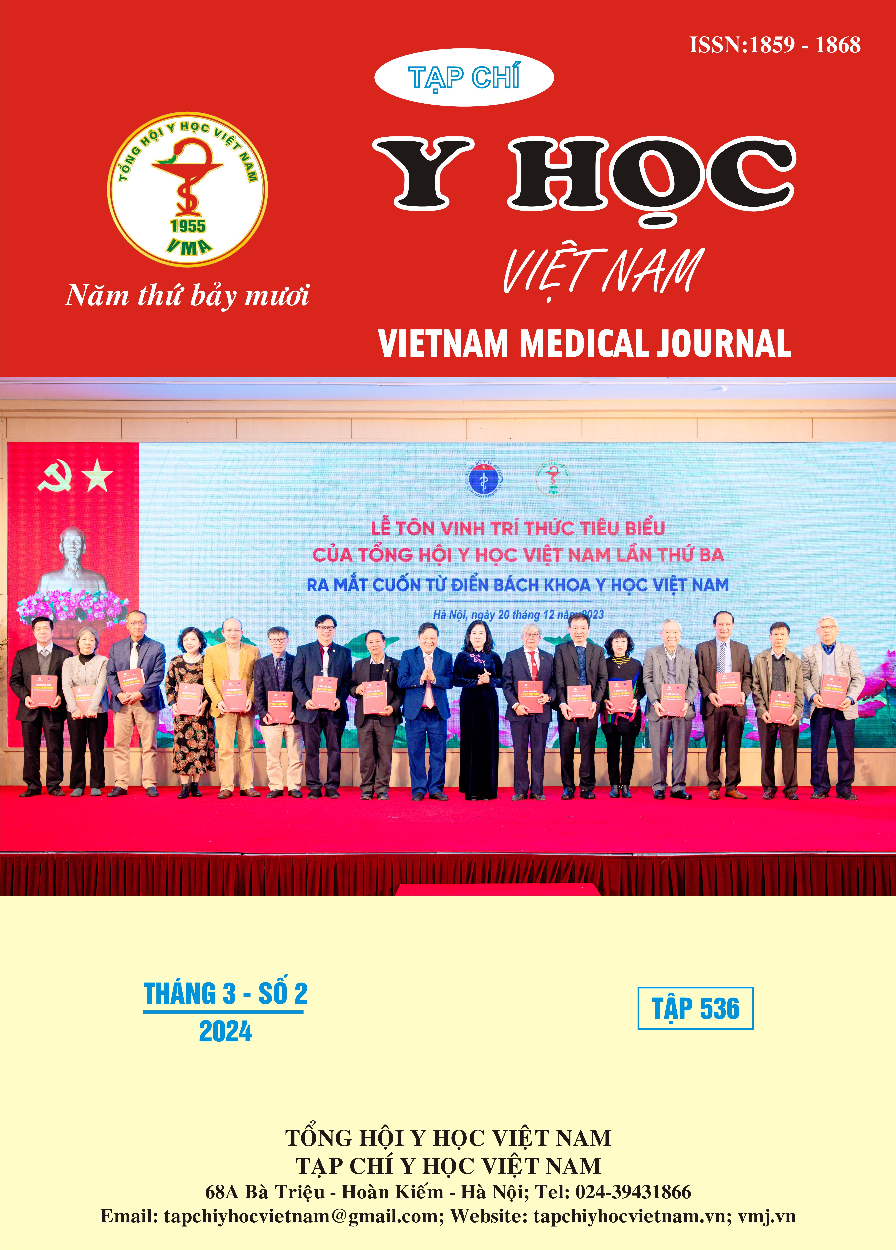COMPARISON OF CLINICAL CHARACTERISTICS, ENDOSCOPY AND MULTI-SLICE COMPUTED TOMOGRAPHY IMAGES OF FUNGAL ASPERGILLUS TO OTHER FUNGAL SINUSITIS
Main Article Content
Abstract
Purpose: The aim of this study was to compare the clinical, endoscopic and multi-slice computed tomography (CT) characteristics of sinusitis caused by Aspergillus fungus with other types of fungi.Material and methods: Descriptive study on 21 fungal sinusitis patients whose fungus was identified by culture or analysis of postoperative specimens from January 2022 to July 2023 at Hanoi Medical University Hospital. These patients underwent clinical examination, sinus endoscopy, and multi-slices CT scan of the sinuses before surgery. The clinical, endoscopic and multi-slice CT characteristics of Aspergillus and other fungi sinusitis were analyzed, described and compared.Results: Aspergillus was isolated in 16/21 patients who were identified as fungal sinusitis, accounting for 76.2%, the remainder were other types of fungi. Chronic invasive fungal sinusitis was found in 9/16 patients (accounting for 56.3%) who infected with Aspergillus fungus but found in all patients infected with other types of fungi. Sinus mycetoma was only found in patients infected with Aspergillus fungus, accounting for 43.7%. The average age of patients was 54.4±11.3, of which 16 were female (accounting for 76.2%). The majority of patients had a healthy history (13 patients, accounting for 62%) followed by dental diseases that had undergone endodontic treatment (accounting for 19%). Main clinical symptoms such as nasal discharge, stuffy nose and migraine were more common in patients with Aspergillus fungal than in patients with other fungal. On sinus endoscopy, patients infected with Aspergillus fungus often experience pus on the floor and nasal recesses, while patients infected with other types of fungi often experience edema of the nasal mucosa. Mucous pus in patients infected with Aspergillus was found in both the middle and sphenoidal recesses, while in patients infected with other fungi, it was only found in the middle recess. Regarding the location of the infected sinuses on CT scan, other types of fungi was only found in the maxillary sinus on one side and one sinus (accounting for 100%), while Aspergillus fungal infection was found on both sides (accounting for 18.7%) and in sphenoid sinus (accounting for 18.8%). Regarding CT signs, opacities completely occupying the sinus cavity were seen in 100% of patients infected with other types of fungi while only seen in 62.7% of patients infected with Aspergillus. There was 01 patient with Aspergillus manifested by homogeneous sinus opacities, and 01 patient had mixed calcifications. The remaining patients were infected with Aspergillus and other fungi, manifested by heterogeneous sinus opacities as well as central calcification.Conclusion: Although the sample size was not big, our study showed that nearly half of patients with Aspergillus sinusitis had sinus mycosis, while other types of fungi were all chronic invasive fungal sinusitis. Sinus lesions of Aspergillus was found in the sphenoid sinus, created partial sinus opacities and mixed calcifications, while other fungi created complete sinus opacities, only seen in the maxillary sinuses and central calcifications.
Article Details
References
2. Safirstein BH. Allergic bronchopulmonary aspergillosis with obstruction of the upper respiratory tract. Chest 1976; 70: 788-790.
3. Jones JR. Paranasal aspergillosis, a spectrum of disease. J Laryn Otol 1993; 108: 773-4.
4. Mauriello JA, Yepez N, Mostafavi R, Barofsky J, Kapila R, Baredes S et al. Invasive rhinosino-orbital aspergillosis with preeipituous visual loss. Opthalmol 2005;30: 124-130.
5. Adler SC, Isaacson G et al. Invasive aspergillosis. J Oto Laryngol 1997; 18: 230-234.
6. Chen JC, Ho CY. The significance of computed tomographic findings in the diagnosis of fungus ball in the paranasal sinuses.Am J Rhinol Allergy. 2012 Mar-Apr;26(2):117-9.
7. Ho CF, Lee TJ, Wu PW, Huang CC, Chang PH, Huang YL, et al. Diagnosis of a maxillary sinus fungus ball without intralesional hyperdensity on computed tomography. Laryngoscope. 2019 May;129(5): 1041-5.
8. Dhong HJ, Jung JY, Park JH. Diagnostic accuracy in sinus fungus balls: CT scan and operative findings. Am J Rhinol. 2000 Jul-Aug;14(4): 227-31.
9. Lê Đức Đông. Nghiên Cứu Đặc Điểm Lâm Sàng, Cận Lâm Sàng và Đánh Giá Kết Quả Điều Trị Của Viêm Mũi Xoang Do Nấm. luận văn CK cấp II. Đại học Y Hà Nội; 2019.
10. Khan AR, Ali F, Imran N, Khan NS, Din S. Invasive sino-orbital aspergillosis in


